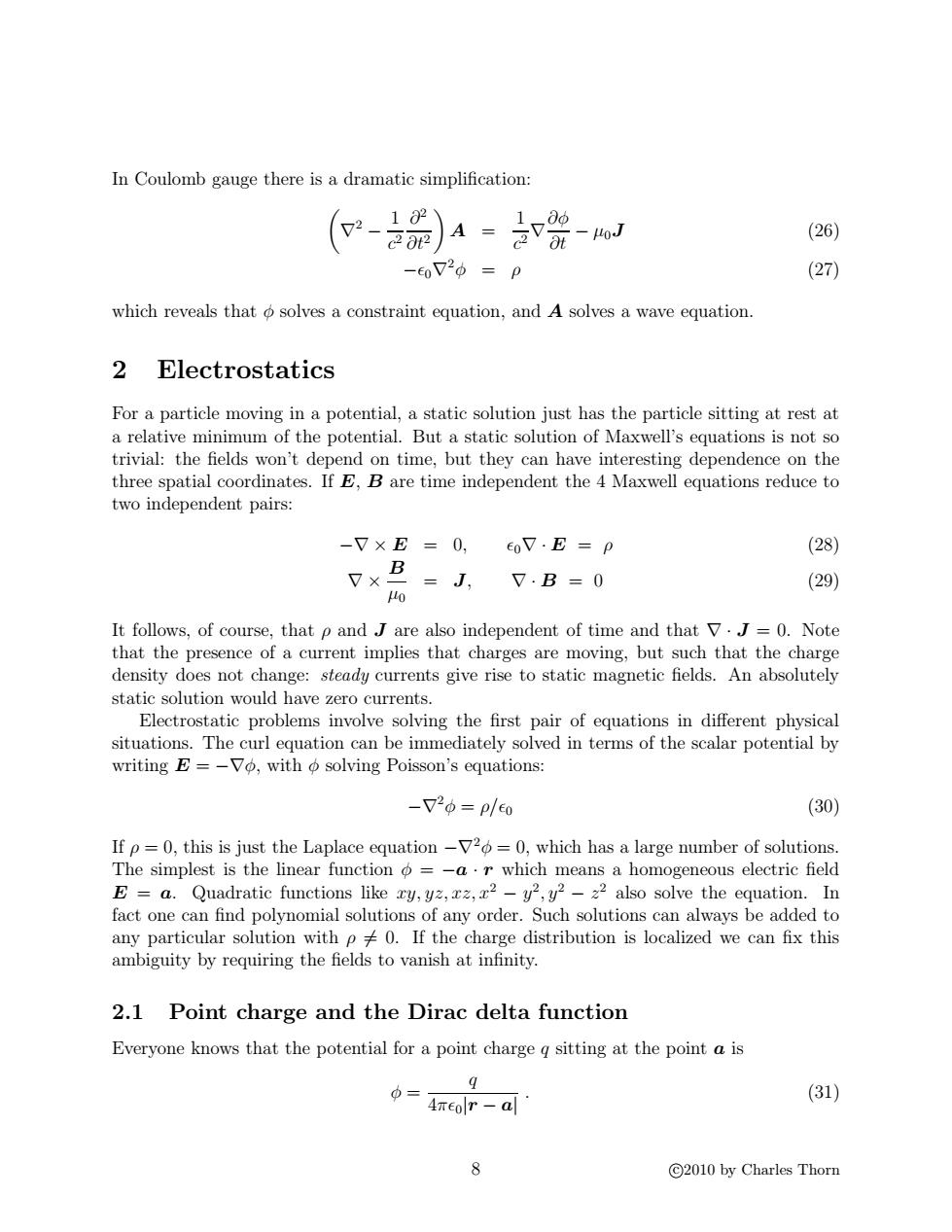正在加载图片...

In Coulomb gauge there is a dramatic simplification: 102 20 A= -HoJ (26) -0720=p (27) which reveals that o solves a constraint equation,and A solves a wave equation. 2 Electrostatics For a particle moving in a potential,a static solution just has the particle sitting at rest at a relative minimum of the potential.But a static solution of Maxwell's equations is not so trivial:the fields won't depend on time,but they can have interesting dependence on the three spatial coordinates.If E,B are time independent the 4 Maxwell equations reduce to two independent pairs: -V×E=0, eoV·E=p (28) B 7×=J, 7.B=0 (29) 0 It follows,of course,that p and J are also independent of time and that V.J=0.Note that the presence of a current implies that charges are moving,but such that the charge density does not change:steady currents give rise to static magnetic fields.An absolutely static solution would have zero currents. Electrostatic problems involve solving the first pair of equations in different physical situations.The curl equation can be immediately solved in terms of the scalar potential by writing E=-Vo,with o solving Poisson's equations: -2o=p/Eo (30) If p=0,this is just the Laplace equation-V2=0,which has a large number of solutions. The simplest is the linear function o=-a.r which means a homogeneous electric field E a.Quadratic functions like ry,yz,xz,x2-y2,y2-22 also solve the equation.In fact one can find polynomial solutions of any order.Such solutions can always be added to any particular solution with p 0.If the charge distribution is localized we can fix this ambiguity by requiring the fields to vanish at infinity. 2.1 Point charge and the Dirac delta function Everyone knows that the potential for a point charge g sitting at the point a is 9 =4Tcolr -al (31) 8 ©2010 by Charles ThornIn Coulomb gauge there is a dramatic simplification: ∇2 − 1 c 2 ∂ 2 ∂t 2 A = 1 c 2 ∇ ∂φ ∂t − µ0J (26) −0∇2φ = ρ (27) which reveals that φ solves a constraint equation, and A solves a wave equation. 2 Electrostatics For a particle moving in a potential, a static solution just has the particle sitting at rest at a relative minimum of the potential. But a static solution of Maxwell’s equations is not so trivial: the fields won’t depend on time, but they can have interesting dependence on the three spatial coordinates. If E, B are time independent the 4 Maxwell equations reduce to two independent pairs: −∇ × E = 0, 0∇ · E = ρ (28) ∇ × B µ0 = J, ∇ · B = 0 (29) It follows, of course, that ρ and J are also independent of time and that ∇ · J = 0. Note that the presence of a current implies that charges are moving, but such that the charge density does not change: steady currents give rise to static magnetic fields. An absolutely static solution would have zero currents. Electrostatic problems involve solving the first pair of equations in different physical situations. The curl equation can be immediately solved in terms of the scalar potential by writing E = −∇φ, with φ solving Poisson’s equations: −∇2φ = ρ/0 (30) If ρ = 0, this is just the Laplace equation −∇2φ = 0, which has a large number of solutions. The simplest is the linear function φ = −a · r which means a homogeneous electric field E = a. Quadratic functions like xy, yz, xz, x 2 − y 2 , y 2 − z 2 also solve the equation. In fact one can find polynomial solutions of any order. Such solutions can always be added to any particular solution with ρ 6= 0. If the charge distribution is localized we can fix this ambiguity by requiring the fields to vanish at infinity. 2.1 Point charge and the Dirac delta function Everyone knows that the potential for a point charge q sitting at the point a is φ = q 4π0|r − a| . (31) 8 c 2010 by Charles Thorn